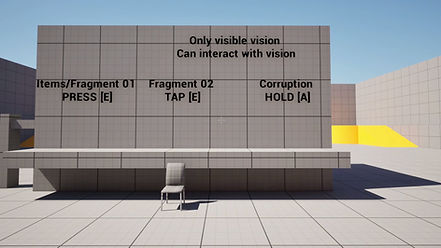

DESCENT OF GRACE
Descent of Grace was born somewhat by accident. Initially, I just wanted to create a level for Blocktober, as a way to explore a few level design ideas. But over time, the concept grew : ideas for gameplay, atmosphere, and storytelling started coming together… until I thought: “Why not turn this into my first solo game?”
So I decided to dive into a genre I had never developed before, but have always loved as a player: horror games. This project allows me to explore a new side of my creativity and push my technical limits.
TECHNICAL SHEET
DEVELOPMENT : Solo Dev
RELEASE DATE : 2026-2027
TYPE : Walking Simulator
GENRE : First-Person, Psychological Horror
SUPPORT : PC (on STEAM)
ENGINE : Unreal Engine 5
INSPIRATIONS : Hellblade, Alan Wake II, Silent Hill 2, Ghostwire: Tokyo

WALKTHROUGH - First Level
BLOCKOUT GALLERY
PITCH
Descent of Grace is a narrative and psychological horror exploration game in which the angel Lyel descends into an intermediate world to save the soul of her twin brother, Elyon.
Each level represents a form of suffering : shame, fear, paranoia, patience… that she must overcome to bring peace to her brother.
The Scars she earns bear witness to her journey: marks left by each purified fragment and by what she sacrifices to save him.
The game explores the theme of compassion: how far can one go to help another without losing oneself?

GAME OBJECTIVES & CONDITIONS
Objective → Find her brother.
Victory conditions → Lyel collects enough fragments to advance to the next level.
Defeat conditions → Lyel loses control of her breathing or her stress gauge reaches its maximum; the player restarts the level.
GAMEPLAY LOOP BY LEVEL
-
Observe → Explore the environment to spot fragments.
-
Feel / React → Use vision to reveal hidden elements (increases the gauge).
-
Manage → Control the gauge through breathing.
-
Risk → Avoid or face entities that raise the gauge.
-
Purify → Collect and purify fragments to progress the story.
-
Repeat / Progress → Move to the next level.

LAYOUT TOP DOWN
After writing several pages of the pitch, I wanted to give the game form through a top-down view, starting with a school as the first level.
This place embodies Shame, where Lyel moves through heavy gazes and students reflecting Elyon’s inner pain.
The player must control breathing and close their eyes to find fragments : objects, NPCs, or scenes, that erase painful memories. Each fragment strengthens a Mark and gradually reveals the lore and the reasons behind Elyon’s fall.

CORE GAMEPLAY & SCRIPTING
What has been done?
1. Fragments → collect them to progress the story and reset the gauge.


Type 1 fragments and objects/items are visible without using the vision.
Type 2 fragments and corruptions are elements only visible when the player activates Lyel’s vision.
I decided to create several MasterItems containing the collision surface, the static mesh, and the associated widget to keep things flexible in use. Those that require vision have assigned tags that allow them to become visible when vision is activated.
2. Vision control → reveals fragments but increases the gauge.

Our character can control her vision, allowing her to close her eyes to reveal hidden passages or collect fragments.
This system is managed through a Post Process switch assigned to the Character, which loads and unloads the relevant elements during the blink.
This approach effectively disguises the loading process, creating a smoother and more immersive transition.
3. Basic Interactions/Movements → includes the addition of crouching, as well as core interactions such as opening doors, collecting objects, and activating environmental elements. These actions form the foundation of player control and exploration within each level.


What's next?
1. Breathing control → helps Lyel stay centered and reduce the gauge.
2. Gauge → represents Lyel’s emotional state; it varies depending on her actions.
3. Entities → increase the gauge based on their number and proximity.
4. Inventory & Collection System → collecting fragments adds them to the inventory; all collected fragments can be reviewed. The number of purified fragments is tracked and helps progress the lore.
CHALLENGES ?
Learning scripting
Having rarely done scripting before, this project was the perfect opportunity to develop this skill. I learned a lot on the fly, but it took significant time to understand how Blueprints work, consulting blogs, YouTube tutorials, and other online resources. This process was both demanding and time-consuming.
Analyzing references
To create coherent gameplay and gamefeel, I spent time replaying all my reference games. Observing mechanics, gameplay loops, and emotional pacing helped me shape the experience I wanted to deliver. This analysis was lengthy but crucial for aligning the game with its vision.
Production and documentation
Even with a background in game design, being the sole developer means I must centralize all elements in clear documentation (Game Design Document, Level Design Document). I also need to maintain a global vision while respecting the technical constraints I set for myself, ensuring the development process remains feasible.









